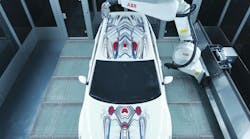So that Happened: Fisker Cars to be Made in Ohio, Girl Scouts Plan for STEM Futures, Finding a Place for those Extra Supplies
Editor’s note: Welcome to So That Happened, our editors’ takes on things going on in the manufacturing world that deserve some extra attention. This will appear regularly in the Member’s Only section of the site.
Printing Cool on Cars
Robotic painting revolutionized automaking decades ago, reducing water, chemical and energy needs in plants by avoiding overspray and providing the repeatability and predictability that car companies needed. But, aesthetically, the technology focused more on consistent paint application than cool designs.
A few years ago, ABB Robotics tried to tackle that challenge with PixelPaint, a technology similar to computer inkjet printing, just done at automotive scale with giant 6-axis robots (I wrote about the technology for another publication in 2020 while looking at the increasing popularity of two-tone paintjobs on new cars).
ABB continues to promote the system as a way for automakers to add complex, custom graphics to vehicles at the factory level, giving them the ability to protect designs with clearcoats and even warranty custom work. So, clearly the next step is getting an 8-year-old artist involved in the process.
Indian child prodigy Advait Kolarkar worked with and Dubai-based digital design collective Illusorr and ABB engineers to create a robot-painted art car—combining Kolarkar’s swirling, monochromatic design with Illusorr’s tri-color geometrical patterns.
Equipped with 1,000 nozzles in the printer head, ABB’s IRB 5500 paint robots completed the highly complex artworks in less than 30 minutes. Sami Atiya, president of ABB’s Robotics & Discrete Automation business area, said the project demonstrates the technology’s ability to “allow any design to be replicated in a manner that is both sustainable and affordable.”
Robots painted the designs on a refurbished a Volkswagen SUV that was damaged in the catastrophic floods in Germany in the summer of 2021.
A New Inventory Challenge: Where to Put It
During a recent conversation, a manufacturing operations executive shared one of his company’s tactics for dealing with what remains a very uncertain supply chain: hoarding inventory. His words were but a repeat of the same message heard first-hand from other manufacturing leaders or anecdotally via the grape vine.
While the inventory decision solved one problem in the short term, it has created another—a lack of space to store that inventory. The manufacturer simply did not have room onsite and was scrambling to find some spare warehouse opportunities somewhere.
Given recent data released by real-estate services firm JLL, warehouse space may remain hard to come by. The national vacancy rate for industrial space in the first quarter of 2022 dropped for the sixth consecutive quarter, settling at 3.4% even as new inventory comes online. A significant portion of that industrial space is warehouse and distribution stock, much of which is being snapped up by third-party logistics companies and other logistics and distribution providers. Rental rates also are up 16% since the first quarter of 2021, the report said.
Nothing in the 2022 first-quarter outlook suggests that finding warehousing space will ease anytime soon. For manufacturers looking to store inventory offsite, that means be prepared to look long and hard, and to pay rising rates. Not an ideal situation.
Of course, there’s another not-ideal situation underway if hoarding inventory is a widespread practice. Bullwhip effect, anybody?
Girls Scouts Sell Cookies and STEM
As anyone who has dealt with the girls who sell Girl Scout cookies knows, these girls aim high.
Well, the Ohio division of the organization also aims high. In May, the Girl Scouts of Ohio’s Heartland announced they are building a $16 million facility in Columbus, Ohio, to attract more women to STEM careers. At the national level the organization has a goal of putting 2.5 million girls in the STEM pipeline by 2025.
It will be somewhat as a challenge if you look at the Ohio State University, also located in Columbus. The Columbus Dispatch reported there 2,130 female students, 24% of the total enrollment, in Ohio State's College of Engineering at the undergraduate level last fall, up from 23.5% or 2,062 from fall 2016 semester. The number of female students at the undergraduate level majoring in computer science and engineering jumped from 180 (13.5%) in 2016 to 328 (16%) last fall semester.
The facility, to be called the STEM Leadership Center & Make Space, will have science and technology labs and a space to teach trade skills like welding, mechanics and carpentry.
At this point about $9.45 million of the $16 million needed for the project has been raised. So, manufacturing leaders, if you want a future workforce, how many boxes of Thin Mints can we put you down for this year?
Will the price still be right?
For once, the official news didn’t take long.
Foxconn leaders had talked about, once they’d bought the place, wanting to bring other contract manufacturing work to Lordstown, where its namesake electric truck maker is only taking up a fraction of the total space.
Foxconn and California-based Fisker plan to start producing the Pear in 2024 on a new platform that also will be the foundation for two future Fisker models. (Fisker’s first car, the Ocean, will start being built this fall in Austria by Magna Steyr.) At full throttle, the companies say they will produce at least 250,000 Pears annually in Northeast Ohio, a number that suggests a hefty hiring spree ahead.
Another detail definitely worth noting: The Pear will have an expected base price below $29,900 before incentives in large part because it’s been designed and engineered with fewer parts. That price is both well below where many EV makers are marketing their models—with investors and analysts regularly pushing them to significantly hike prices—and might be a challenge for Fisker executives to stick with for another two years given today’s inflationary pressures and those in the pipeline.
If it starts to look like Fisker can perfect that price point, look for plenty of peers—legacy and startup—to pay serious attention.





